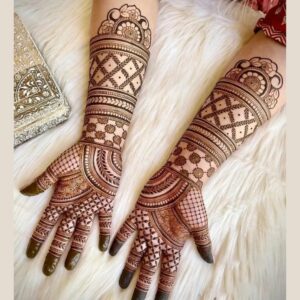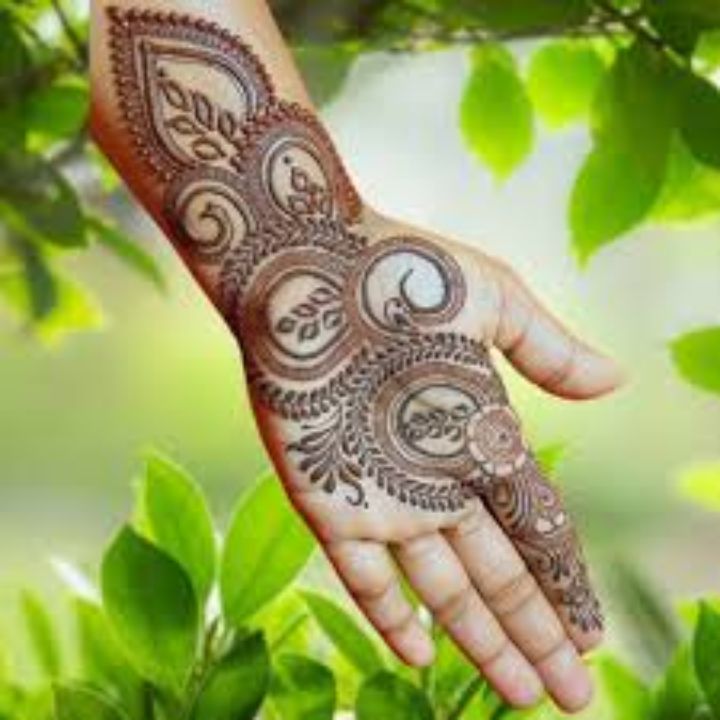Mehndi design also known as henna art, has been an integral part of various cultures especially in South Asia the Middle East and parts of Africa.
It is a tradition that dates back thousands of years and continues to be celebrated in numerous festivals weddings and other special occasions.
What is Mehndi Design?
Mehndi design refers to the intricate patterns and motifs that are drawn on the skin using a paste made from henna leaves.
The paste is applied on the hands feet and other parts of the body creating temporary tattoos that can last anywhere from a few days to a few weeks.
The designs vary in complexity ranging from simple and elegant patterns to highly detailed and ornate artwork.
Mehndi design holds cultural, spiritual and aesthetic significance especially during weddings festivals and celebrations.
It is considered a symbol of beauty, good luck, and positive energy. In recent years, mehndi design has transcended cultural boundaries and become a popular art form worldwide.
The History of Mehndi Design
The practice of applying henna to the skin was not just limited to aesthetic purposes but also had medicinal and spiritual importance.
In some cultures, henna was used to cool the body temperature during hot weather, while in others, it was believed to ward off evil spirits.
In India, mehndi design became an essential part of wedding rituals, where brides and their families would apply intricate henna designs on their hands and feet.
Over time, mehndi design evolved, incorporating various styles, such as Arabic, Indian, Moroccan, and African, each with its unique characteristics and symbolism.
Types of Mehndi Designs
There are numerous types of mehndi designs and each style reflects a particular cultural influence. Let’s explore some of the most popular types:
1. Arabic Mehndi Design
Arabic mehndi design is characterized by bold and flowing patterns. It often features large, curved shapes, floral motifs, and geometric patterns.
Unlike Indian mehndi designs, Arabic designs are generally less intricate, with more open spaces and a focus on bold outlines. This style is perfect for brides who prefer a more contemporary look.
2. Indian Mehndi Design
Indian mehndi designs are known for their intricate details and complex patterns. They often include motifs such as paisleys, peacocks, flowers, and mandalas.
Indian mehndi designs are heavily symbolic, with each designs element representing different cultural and spiritual meanings.
3. Moroccan Mehndi Design
Moroccan mehndi designs incorporates geometric shapes and patterns, often with a symmetrical layout. The designs are bold and have a tribal influence, reflecting the cultural heritage of Morocco. Moroccan mehndi designs can be both minimalistic and elaborate, depending on the wearer’s preference.
4. African Mehndi Design
African mehndi designs are unique in their use of bold lines, dots, and shapes. These designs are simple yet impactful, focusing on strong, bold elements.
5. Bridal Mehndi Design
Bridal mehndi designs is one of the most intricate and elaborate forms of mehndi. For brides, the mehndi designs is an essential part of the wedding celebrations, and the designs are often elaborate, covering the hands, feet, and sometimes even the arms and legs.
Bridal mehndi designs can include symbolic elements such as the bride and groom’s initials, wedding symbols, and motifs that represent love and unity.
6. Contemporary Mehndi Design
Contemporary mehndi designs blends traditional henna art with modern trends. It may include minimalist designs, geometric shapes, and even designs that incorporate elements like beads, stones, or glitter.
This style is perfect for individuals who want to add a contemporary touch to their mehndi while still honoring the tradition.

Latest Trends in Mehndi Design
While mehndi designs has deep cultural roots, it is constantly evolving to keep up with modern aesthetics and preferences. Here are some of the latest trends in mehndi designs that are gaining popularity:
1. Minimalist Mehndi Design
Minimalism is making its way into the world of mehndi designs. Many individuals are opting for simple, clean lines, and delicate patterns that focus on subtle beauty.
These designs often feature small floral elements or geometric shapes that create a refined, elegant look.
2. Glitter Mehndi Design
Glitter mehndi designs has become increasingly popular for special occasions, especially for brides. Adding glitter to the mehndi designs not only enhances its visual appeal but also gives the designs a glamorous and festive touch.
3. Colored Mehndi Design
Colored mehndi comes in various shades, such as red, green, blue, and gold, allowing individuals to experiment with different hues and create eye-catching designs.
4. 3D Mehndi Design
3D mehndi designs is a cutting-edge trend that creates the illusion of depth and dimension on the skin. This style uses multiple layers of henna paste to create raised patterns that add texture to the design. 3D mehndi designs are typically more intricate and require a skilled artist to achieve the desired effect.
5. Finger Mehndi Design
Finger mehndi designs focuses on intricate patterns applied to the fingers. This style often includes lace-like designs, floral motifs, and thin lines that add elegance and sophistication. Finger mehndi is perfect for those who want a subtle yet stylish designs.
Also Read: Gold Chain Designs
Tips for a Perfect Mehndi Design
Achieving a beautiful mehndi designs requires skill, patience, and the right techniques. Here are some tips to ensure your mehndi designs turns out perfect:
- Choose a skilled artist
Whether you’re getting a professional mehndi designs or doing it yourself, ensure that you choose someone with experience and expertise in henna art. - Use fresh henna
Fresh henna will give you the best color results. Make sure the paste is prepared with high-quality henna powder and is applied fresh. - Let it dry completely
After applying the mehndi designs allow the paste to dry for several hours. The longer the paste stays on the skin, the darker the stain will be. - Moisturize
After removing the dried henna paste, moisturize the skin to enhance the color and keep the design looking fresh.
Final Thoughts Of Mehndi Design
Mehndi designs is a beautiful and meaningful tradition that has evolved over centuries. From its cultural significance to the wide variety of styles and trends, mehndi continues to captivate people around the world.
Whether you’re attending a wedding or celebrating a special occasion, mehndi designs adds a personal and artistic touch to any celebration.
If you’re considering getting a mehndi designs explore different styles and trends to find the one that best suits your personality and occasion.
With so many intricate patterns, cultural influences, and modern twists, the world of mehndi designs is full of endless possibilities.







